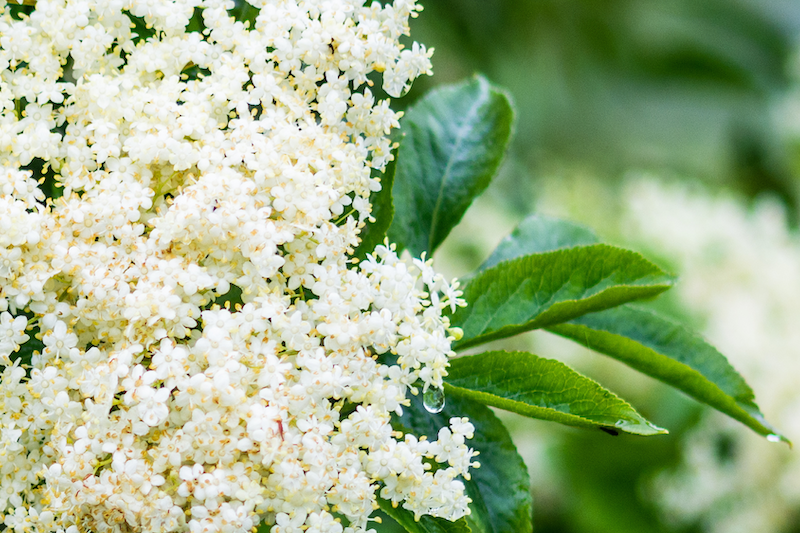You are about to leave the Herb Pharm website. The website will open in a new browser window.
Please select "OK" to continue to the website, or close this box to return to Herb-Pharm.com.

Sambucus nigra
Plant Family
Viburnaceae – Viburnum family (syn. Caprifoliaceae, Adoxaceae)
Other Names
European elder, black elder1
Parts Used
flower
Uses
Traditionally used to make cordials, liqueurs, and other homemade drinks.
Prominent Phytochemicals
Prominent Constituents Reported in the Scientific Literature:
Flavonoids, phenolic acids, triterpenes, sterols, essential oils, tannins, mucilage, and polysaccharides.2,3,4
The Elder tree has a rich history of superstition, folklore and mysticism.3,6
Description
Origins & History
Elder is indigenous to Europe, North Africa, North America and Asia.4,8 The herb is mostly wildcrafted in western Asia and eastern Europe.7
The shrub prefers moist soil in hedges, woods and vacant land in temperate regions.3 In the spring, it can be propagated from cuttings.3 The flowers are harvested in full bloom and must be collected during their brief, three-week flowering window.3,6 To remove the petals from their flower stalks, they are collected and piled for a few hours to slightly heat them.3,6 The heat loosens the petals, which can easily be removed from the remaining parts by sifting.3,6
Use of the plant in herbalism dates back to the physician Hippocrates, during the Classical period in ancient Greece, and to the first century in the Roman Empire, with the naturalist, Pliny the Elder.6
Elder is used in Native American Herbalism (including internal and external applications, as well as food).5 This and other Sambucus species were used extensively by the Cherokee and many other tribes across North America.5
Traditionally the pith of young Elder branches were hollowed out to create a tube used for stoking fires by breath, pipes and children’s toys.6 The wood was utilized for butcher skewers, combs, both musical and mathematical instruments, weaving net rods, and other tools.6 The root and mature bark have been used as a black dye in the Scottish Highlands.4,6
The flowers have long been used in Britain and Scandinavia for wines, winter cordials, and other homemade drinks.6
While both the flower and berry from the same plant are used in Traditional Western Herbalism, they have different uses.
For extraction no heat is necessary. However, the ripe berries and flowers should be dried prior to processing to denature the compound. Elder flower has the highest safety rating possible in the Botanical Safety Handbook, 2nd edition and no issues are typical or expected when processed correctly. This includes using the dried flower with no other plant parts such as stems or leaves included.
The Elder tree has a rich history of superstition, folklore, and mysticism, more so than most European herbs.3,6 In Denmark and England, the “Elder Mother” protects the tree and you must recite her rhyme for consent before harvesting or altering any part of the plant.3,6 This superstition has led some landscapers to refuse to work with the Elder tree.6 In other countries, the tree was said to protect against evil and sorcery; it was also grown near residences for this purpose.6 In the late 1600s, the leaves would be gathered on April 30 and secured to houses for safeguarding against evil.6
References
Don't forget! Check your Rewards account for coupons.
CHECKOUT
You are about to leave the Herb Pharm website. The website will open in a new browser window.
Please select "OK" to continue to the website, or close this box to return to Herb-Pharm.com.